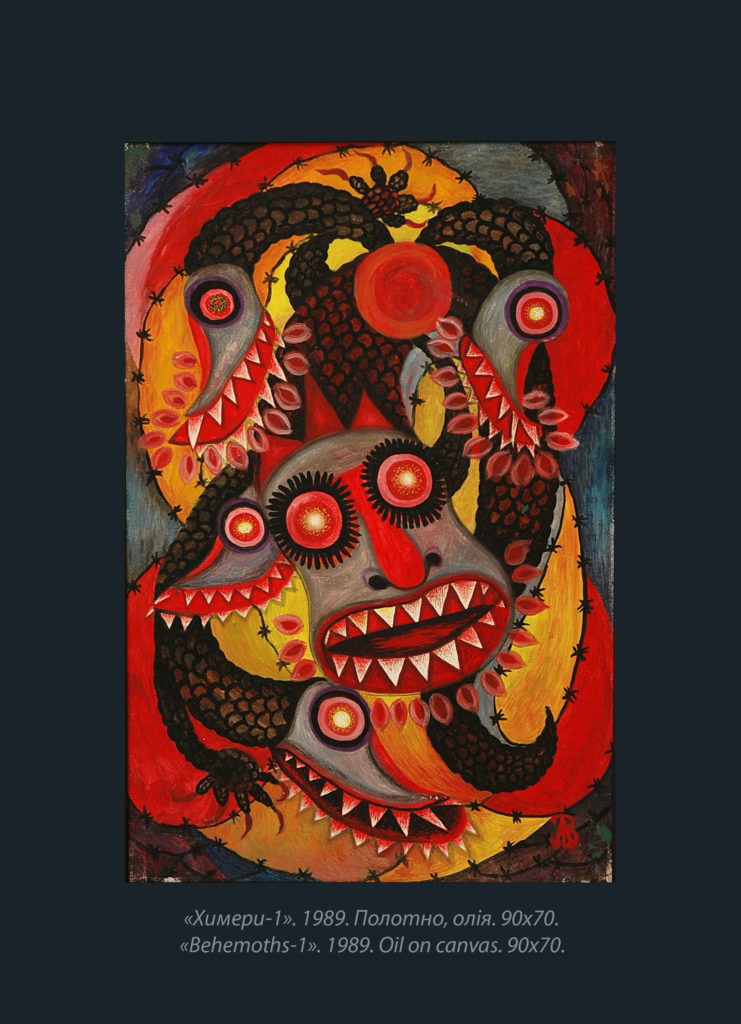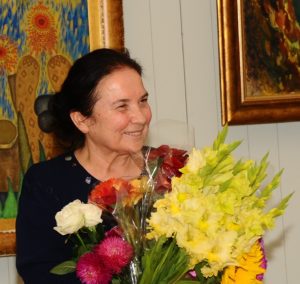
Elena Shapiro is an art critic.
According to the acknowledgment of artists, writers, poets and art critics, Ludmila’s works radiate the solar warmth of love for the world, which still amazes her with revelations as she had long ago, in her childhood. how the life of man, in particular, that of a creative personality, is arranged according to God’s providence. Ludmila’s God-given gift has been multiplied by her total dedication to the arts: for more than 55 years she has been creating masterpieces that have absorbed the most valuable of national culture.
Lyudmila Ivanovna was born in 1942 in the village of Skybintsi, in the Pogrebyshchensky district of the Vinnytsia region. The first steps to drawing were made in the first years of life – coal from the stove on a whitewashed wall, then the girl mastered the pencil. At six or eight years old, she could not be torn away from beautifully painted children’s books, and Ludmila tried to learn how to draw so well. Early childhood fell on anxious, difficult and hungry years of the Patriotic War, later her family moved to live on the outskirts of Kiev – Vodogin. Ludmila graduated with honors from seven years, sometimes at school she found herself drawing during lessons, and at home she completely indulged in her favorite activity.
The main source of her inspiration was nature: she felt enormous admiration for the rugged old trees and colorful flowers, ponds with dragonflies and frogs, majestic sunrises and sunsets; from ripe plum fruits mysteriously shining under the silver moonlight. Nature captivated Lucy from her early years and for life … So, when it came time to choose a profession, she opened her dream to her family – to become an artist. At first, Antonina’s mother tried to convert her daughter to a more practical profession with a reliable income, but the circumstances still turned out to be for the girl’s dream, and her father Ivan supported her in choosing a profession: “if she likes to draw, then let her go and draw… “
For five years, Lyudmila studied at the Kiev School of Applied Arts, which was very revered in the professional community, at that time, on the territory of the Kyiv-Pechersk Lavra (now the institution is called the Kyiv State Academy of Arts and Design named after Mykhailo Boychuk) weaving, where she gained brilliant skills in composition, drawing, painting and arts and crafts. To this day, she remembers with gratitude and warmth her teachers – Yevgeny Sviatsky, Anatoly Kazantsev, Nina Gan. Then there were three more unforgettable years of learning the secrets of painting at Vasyl Zabashta’s art studio at the October Palace of Culture. Starting in 1959, Ludmila created her own works of art, and since 1963 has taken an active part in wholesale art exhibitions.
With a serious intention for her chosen profession, Lyudmila decided to continue her studies at the Art College and entered the Faculty of Graphic Arts of the Ukrainian Polygraphic Institute. Ivan Fedorov (now called the Ukrainian Academy of Printing), where her teachers were Florian Yurev and Valery Lamakh. Having received her diploma in 1974 in the specialty of “illustrator-artist and book-maker”, the artist continued her experience of working with publishing houses, which practically began in the 1960s. She has collaborated with Motherland Magazine and children’s magazines Malyatko and Sunflower, and has created beautiful illustrations for Lesya Ukrainka, Yakov Shchogoliv, and Dmitry Cherednichenko’s books at Veselka Publishing House. In addition, she worked on illustrations for the collection of “Ukrainian Love Songs” – unfortunately, not published until today for reasons independent of the artist’s will, and became the author of leaflets of the publishing house “Art”.
Later she became a member of the Artistic Studio of the Film Studio, during 1985-1989 she worked at the Ukrainian Studio of Chronicle and Documentary Films (“Ukrhinochronica”) on a series of 11 films on folk tales from different countries of the world. For many years she devoted her time to public work in the Union of Artists of Ukraine, while at the same time in her spare time was engaged in the creative work.
An important stage in the life of the artist was the experience of working as a designer at the National Museum. TG Shevchenko. Lyudmila Zadorozhnaya was sincerely concerned with the preservation of the museum funds and worthy representation of Taras Grigorovich’s creative work in the exposition space. Having seen the painting by Zadorozhnaya, the director of the Shevchenko Museum – Kateryna Doroshenko, invited her to do a solo exhibition. In the future, the tradition of opening days in the halls of the Shevchenko Museum continued for many years.
After joining the National Union of Artists of Ukraine in 1979, Lyudmila, with the support of her husband Valentin, decided to be a freelance artist: having resigned as a museum artist, she devoted herself entirely to painting. To this day, the artist works productively on the open air and at home, creating fantastic and fantastic compositions, amazingly beautiful landscapes and still lifes.
However, a multifaceted personality always strives to try his best to choose the best: Zadorozhny’s work spans absolutely all genres – landscape and still life, story works and portraits, book illustrations and his own fantasy compositions. She uses the author’s technique, tests the possibilities of temperamental painting and pastels, oil paints and watercolors, creates graphic plot compositions and portraits in the technique of ink, pen. Looking at the works of different years, we can say that all these works are combined with the unique outlook of the artist, her inner world, dreams and fantasy, and of course – love of nature.
Ms. Ludmila’s memories of her childhood can be interpreted as a key to understanding her creative personality. Lucy was a very affectionate girl, completely open to the impression of contemplation of nature: in spite of her parents’ complaints, she often ran away from home. Fascinating wanderings led her to the most mysterious and beautiful corners of her village, and even further to the surrounding meadows and lakes: she froze under the hot fire of the summer sun from the untold and untouched beauty of flowers, delighted the hum of trees in the wind, enjoyed the chirping of the birds , Looked at the carefree fuss of butterflies, listened to the concerts of frogs … Everyone knows how during silent contemplation nature reveals itself, and captivates the soul of man in such a way that there is neither power nor desire to escape from the captivity of this Divine Od blood. The eye rejoices at every young rose bud, the nostrils eagerly absorb the scent of the pine-tree sunburnt, the ears enjoy the piercing bell of the bumblebee, and even the tiny drops of morning dew seem like a miracle … .
In her paintings, Lyudmila Zadorozhnaya complements the world of nature with her thirst for the thrilling mystery that lives on in folklore and folk tales. Her paintings and watercolors reveal to us the world of Lake Shores with enormous wise eyes, Flying Horses and adorned with the colors of Dragons, glowing fire of red-golden Firebirds, grotesque Chimeras and beautiful to the beastly white Libidas of the most noble and prodigious Ludmila Zadorozhnaya is very kind, even the most terrifying creatures (from the Chimera cycle) in her performance lose all their anger: the artist turns everything into Beauty and Good, and even as she draws around these creatures lace of flowers, patterns from bright sun rays.
All the riches of the genetic spiritual heritage of previous generations: Christian faith, world art and folklore, the traditions of peasant life – are woven into its canvases, and are enriched with spiritual purity, intelligence, subtle artistic taste.
In the paintings of Lyudmila Zadorozhny you can see everything that subconsciously lives in the Soul of the Ukrainian woman who was born in the village: this chain of traditions was very strong, in particular the attitude to the house as to the Souvenir of the Soul, a reliable and warm place for the whole family. The house itself is at the heart of the peasants’ life, a special space with a sacred red corner with an icon, old chests with dowry, decorative painted wooden utensils, magnificent embroideries with ornamented wishes of health, longevity, prosperity, good fortune … we feel the spirit of the ancestors who for generations lived in close relationship with the Earth itself, which feeds and sustains peasants all the time, even in the horribly starving war years – all of which are genetically embodied in works of art, though not always clearly, but is felt through a certain mood-color and details, barely noticeable symbols.
Among the works devoted to the theme of the native land, the triptych “Yourself in your masters” (1986 watercolor, pastel) should be mentioned first. The artist collected materials for a long time, in particular, went to Sednev where she went to the houses, met with the owners, painted portraits of grandparents. At the same time, looking at their home life and communicating with the old people, she collected in her treasure trove of impressions hundreds of sad or funny, but always quite true stories. Lyudmila deprived her characters of very noticeable individual traits, she writes grandparents in the silvery fog of timeless space, completely beyond all vain anxieties of modern life – so simple and true that it truly attains true grandeur in the image of these people who trust only in God , and according to Ludmila herself, “they know exactly where the good and the evil are, and they do not try to distort the truth so that evil turns into good and good into evil …” She created portraits of heroic people: despite all difficulties and obstacles and – a patriotic war, hunger and godless Soviet ideology, they kept in their hearts and eyes something special – priceless that sorry to lose. The color and plastic design of the work, with all its asceticism, creates a very strong emotional effect – undoubtedly, in this work many years of professional experience and refined artistic taste of the author are felt. Such works are not written by accident or too quickly; it is a mature work of an intrinsically strong and true man, because the triptych “Ourselves in our Lords” is a kind of testimony in the love of our ancestors and Motherland.
The artist continues her monologue about her native land not only in the subjects, but also in landscape works – in particular in the series “Peace of Our Earth” (1985, in the technique of cardboard, tempera), consisting of the compositions “Silence”, “Snow melts” ”,“ Foreboding of Spring ”,“ Thaw ”. It depicts old, quaint trees in the background of hills and forest landscape outside the village. Turning to a well-known motif, the artist skillfully puts into the landscape all the love of a peaceful slice of land in her native village … but at the same time, this seemingly simple landscape has an epic power to influence the viewer and gives us the opportunity to see much more – the whole territory of our lives, Ukraine.
The very imagery of these old trees, which grow from one strong root and have a common origin, and further grow on their own on elastic and strong sprouts, twisting strangely in different directions – are perceived by us as a figurative metaphor of people from the same family who are still living by the laws of their own fate … sometimes even knowing nothing about the fate of their relatives who live far away. It stuns not only the general mood of the series “Peace of Our Earth”, but also the technique, because all the paintings are very carefully painted with the smallest pointillistic dots-dabs, in balanced ochristo-blue-gray range of gentle-pastel colors. The whole landscape space is very bright and transparent, even fresh air is present, the multifaceted composition includes trees and hills, lakes or streams during the thaw, even a peasant’s house is depicted. Everything breathes and radiates harmony, tranquility, silence … and hope for human happiness on this earth, among the “ordinary beauty” of the Ukrainian village.
Most of the story paintings of Ludmila Zadorozhnaya continue the theme of genetic inheritance: admiring the works of different years, the viewer often involuntarily recalls patterns of folk painting. For example, as we will see her work “Cossack Riding on the Danube” (1976, watercolors), the image of a cheerful Mamaiya with a pipe, a bow and a bandura emerges in our memory, we also feel the horrible tragic nature of the works dedicated to the sad pages of Ukrainian history in the works. Cossack Graves (1967, tempera, canvas) and Requiem (1989, oil, canvas).
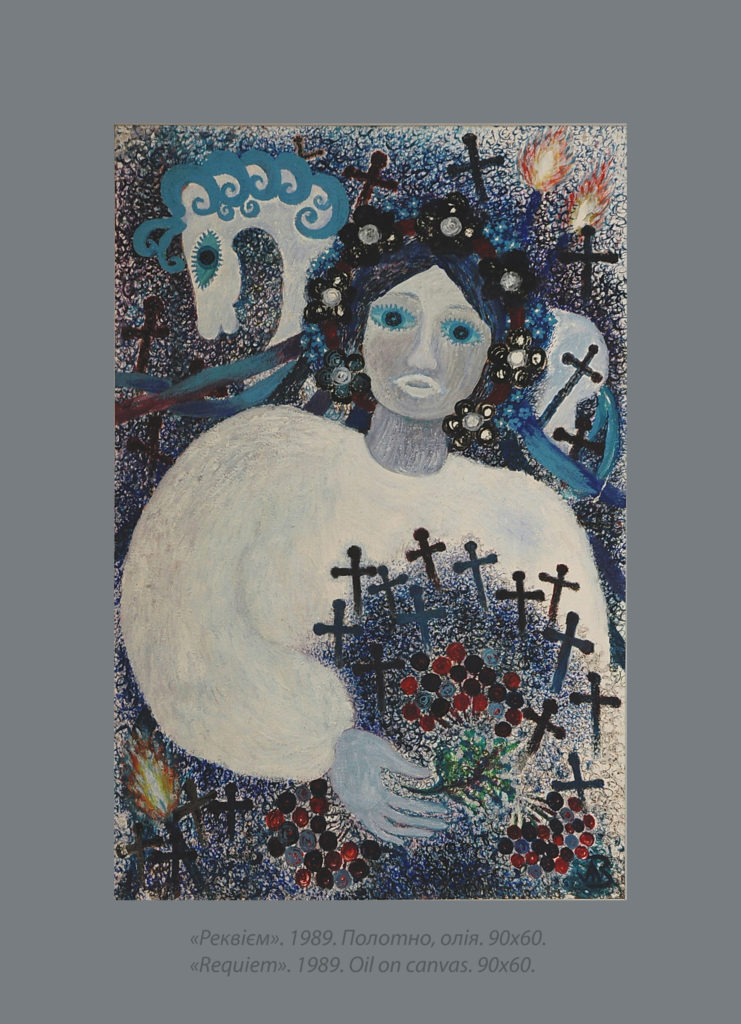
Painting by Ludmila Zadorozhnaya has absorbed all the purity of the artist’s soul, she writes intuitively – with the Soul, with memories of emotions … The very spirit of Zadorozhny’s paintings is often reminiscent of the fictional and beautiful worlds of Henri Rousseau, Nico Pirosmani, Maria Primachenko, Catherine Bilokur. Even Ludmila’s own manner of writing a work, using a tassel as if she was embroidering, makes us think of Bilokur, who, according to the memories of her relatives, “embroidered” with tiny dabs, and attached the canvas to a stretcher like a hoop – with twine, and when the work was completed , removed the recorded canvas and secured it to the frame. Bilokur’s homemade brush resembled a needle; she “made brushes of cowhide, cat hair, cherry twigs, and tin cans …” However, such extreme modesty of artistic materials did not become an obstacle to creating fantastically beautiful paintings, as we also see on the example of painting by Ludmila Zadorozhnaya, who deliberately tries to use an extremely restrained palette in two or three colors, carefully writes out each leaf and petal, writes barely touching the canvas with tiny speckles, gradual picking up color and tone, inspiringly embroiling and flushing out their most talented masterpieces: “Peace of Our Earth” (1985), “Music” (1968), “Awakening” (1972), “Spring” (1972). ), Coast of Lakes (1969) and Mavka (1989), Birds (1989), Consecration (1999), Joy (1985)
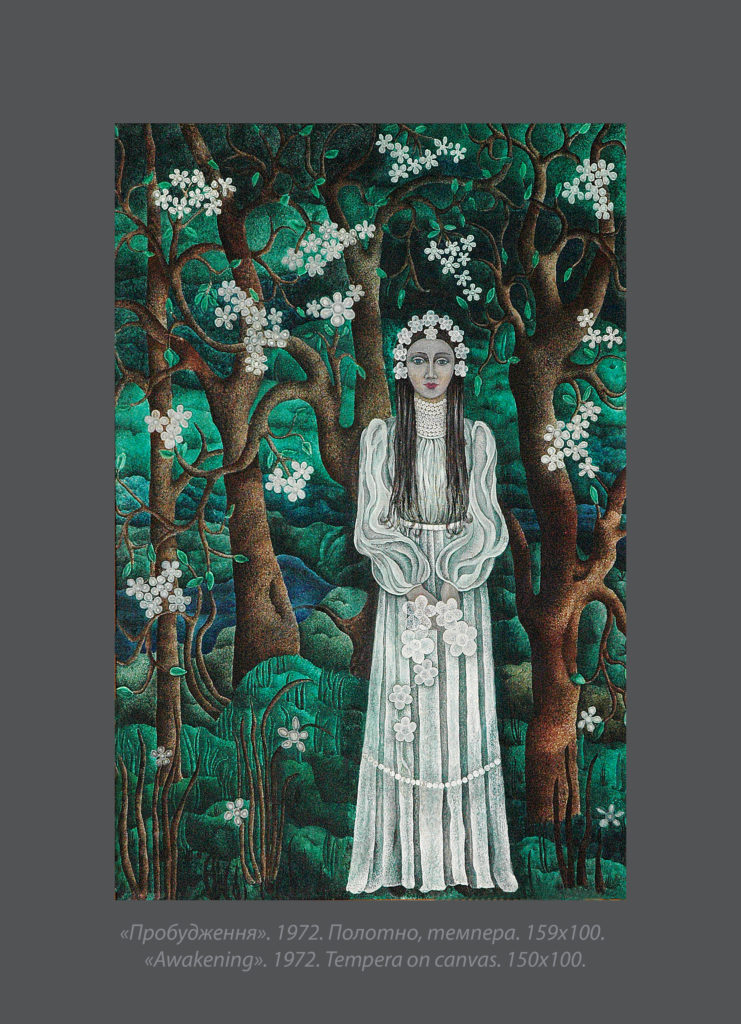
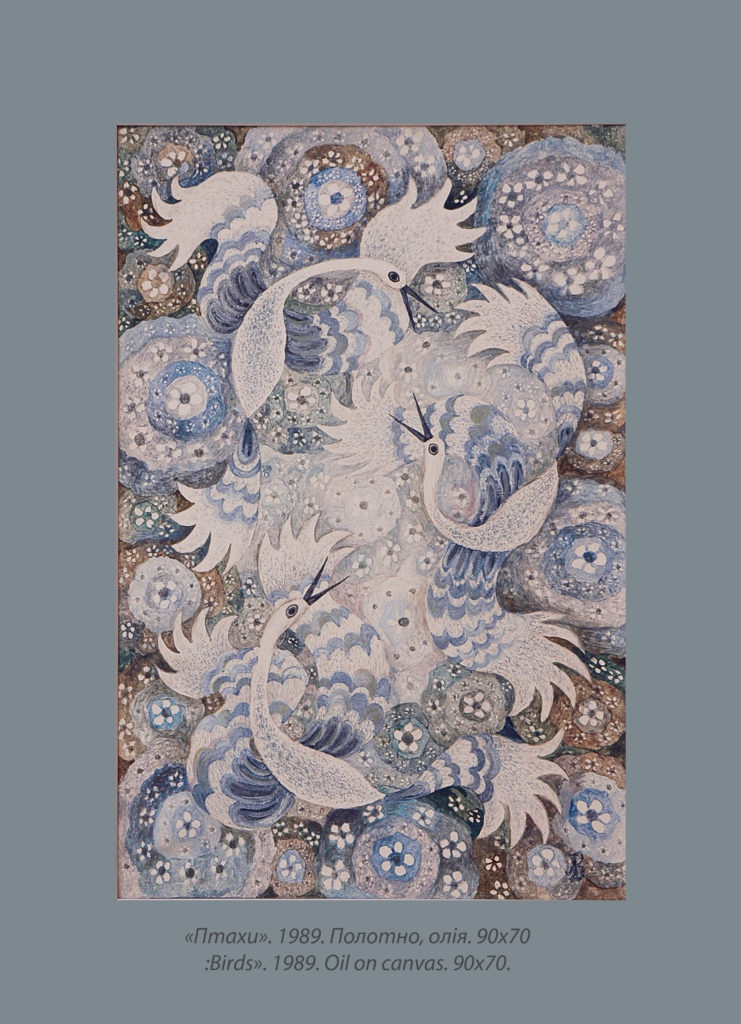
However, not only the peculiarities of the technique of drawing, but to a greater extent – the content of the content of the work, its figurative solution are close not only to naive painting, but also to the models of ancient art. Think of “Chimeras”, “insulting images,” as the artist calls them. The series emerged as a reaction of the artist in the events of the 2014 revolution and the war in eastern Ukraine, a dark chaos in the minds of people during tragic events. If you look at the “Chimera” in the context of world culture, there are immediately associations with ancient Peruvian cult images, and if you turn to the Ukrainian fine arts, the closest are the Fantastic Beasts from the paintings of Maria Primachenko. According to the art critics, the “two-part” image of animals with a definite boundary of the head and torso goes back to the Paleolithic times, so in these images the pagan representations of our ancestors are found, which have echoed in the depths of Slavic mythology in the images of fantastic monsters and birds. So, it can be argued that for many generations these images of chaos have formed in the popular subconscious, in the future the horrors have turned to the fine arts, and we see similar images in the work of Ludmila Zadorozhnaya. Let us also mention some paintings that embody the people’s conception of the fantasy world, namely: “Coast of the Lakes” (1969, cardboard, tempera) “Mavka” (1985, canvas, oil) “White horse and merry dragons” (1989 ., canvas, oil), “Everywhere Eyes” (2003, canvas, acrylic). A childhood artist so deeply embraced these wonderful fairy-tale characters that she later felt the need to give her imagination free rein and let these quirky and beautiful creatures onto the canvas: it was important for her to draw not only beautifully but also mentally, as if singing to the audience about fairy-tales. quietly whispering weird stories.
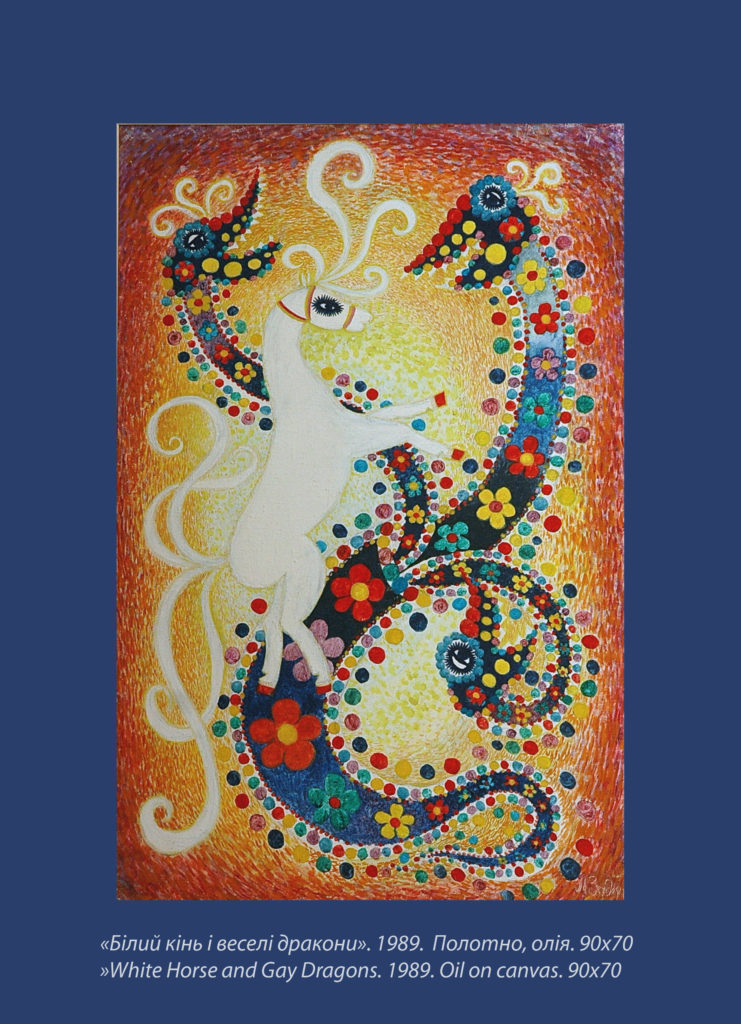
Reflecting on the artist’s style of the artist, it is worth mentioning the specificity of her professional education, because Zadorozhnaya studied at the Faculty of Weaving in an art school, so she had practical experience of making sketches for tapestries. In some ways, this influenced her approach to drawing techniques: for example, “Peace of Our Earth”, “Awakening”, and watercolor “Joy” (with the image of roses) in technique resemble not a traditional painting, but a magnificent tapestry – compositionally impeccable, colorfully refined, hand-woven. Among the works of Ludmila we find many paintings written in this way, and according to the artist herself, she has been working on these works for several months.
The power of Zadorozhny’s speech to the viewer is in the clear simplicity of the “artistic message” to us. Flowers and trees metaphorically tell about the fate of man and his state of mind, about finding the meaning of being in unity with the Creator. The fascination with earth-born beauty is embodied in a series of summer landscapes painted with nature oil paints.
Among the best paintings are “Bells” (2004, canvas, oil), “Summer Day” (2004, canvas, oil), “Hydrangeas bloom” (2005, canvas, oil canvas) “In Captivity of the Summer” (2006 The flower fever is sung by the artist so loudly that the viewer is floating in the ocean of this song, not even noticing the time … The Sunflowers (2000, canvas, oil) is spoken to us by the tremendous power – the artist. draws the petals in such a way that they seem to blazing inside with real sunlight. Ve, like real little sunshine, filled over the edge with the unrestrained joy of being.The painting “Summer Day” (2004, canvas, oil) is created in plum-silver tones that Lyudmila remembers from the time of her childhood: colors really radiate a floral scent, crickets sing loudly, dragonflies fly … and Ludmila’s flowers blossom like a tiny miracle – for only one day, giving us their beauty during their little lives.
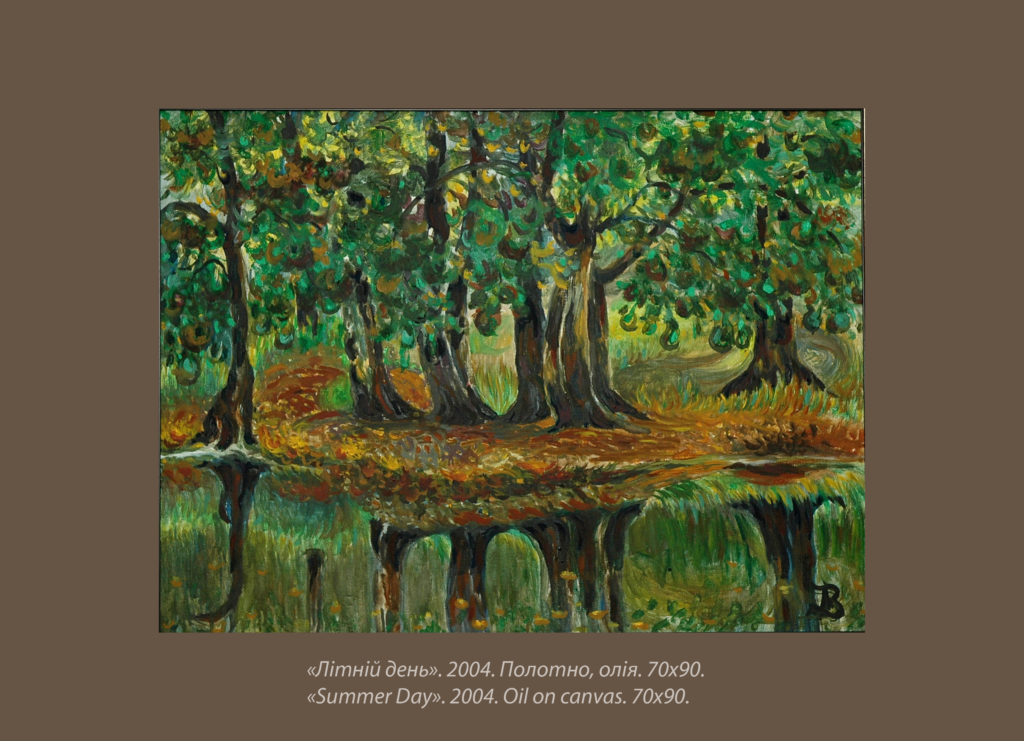
The epitome of singing the beauty of the surrounding world, and not only the earthly nature, but the entire vast Universe, becomes the cosmic work “To the Sun” (1990, canvas, oil): supposedly fantasy, but on a real basis, because all the elements – and the Sun, and the rays are natural, the artist saw this path of light with her inner eye as a special supernatural phenomenon.
A very special place in the artist’s legacy is occupied by female portraits, in which she reveals the emotional state of personality: dreaming, trusting, expectation of love and a better destiny. In Natalka’s portrait (1992, canvas, oil), “Baba’s summer” (1998, canvas, oil) and in graphic portraits, the most striking are the eyes: it is this look that holds the viewer’s attention, reveals something secret and secret in the soul of a woman. From the very beginning of her work on portraits, the artist has been trying to convey the main thing – what is the life of this person, who is winging her and forcing her to move forward with the belief in happiness. However, the artist is able to portray the exterior beauty, because her models are always attractive women who are in a harmonious-balanced state, completely self-sufficient personality.
Developed author’s system of images and symbols, bright colorful gift is the basis of artistic talent of Ludmila Zadorozhnaya, but the most valuable is the spiritual foundation: love for people, love for nature, honoring the traditions of ancestors. History shows that since the beginning of the 1960s the desire of indifferent people to preserve national traditions has matured in the depths of Ukrainian culture. Subsequently, already in the days of Ukraine’s Independence and to this day, our history and art are actively researched: these tendencies are also found in the heritage of Lyudmila Zadorozhny, they elevate her painting to the level of national values. Therefore, no external circumstances are able to shake the solid foundation of Ludmila Zadorozhnaya: her paintings are valued among colleagues and museums, critics and collectors – even though throughout her life, Lyudmila Zadorozhnaya has been and remains completely indifferent to the art ratings, demand and art ratings and demands. in general to any career claim.
Lyudmila generously shares her light with the viewers, her source excessively quenches our thirst: she is constantly immersed in her inner state – into the music of the Soul, contemplation of beauty, quiet harmony, and the viewer gradually opens up all the chords of her creative melody: we seem to float in this ocean of impressions, we are touched tenderly by the waves of summer orange twilight, quiet flutter flute in the plum landscape, the voice of the violin in the dance of youthful beautiful Mavka rings high, and over all this paradise shines the Rainbow of Peace.
Most of Lyudmila Ivanovna Zadorozhnaya’s works are a true anthem of the joy of Life, the artist perceives her paintings as the most valuable things that should always be nearby, so she seldom agrees to sell them. This was understood by her husband Valentin, who throughout his life tried to support his mistress wife, deeply honoring her talent, touching and caring for the preservation of her works. He was very fond of music and art, he was a true intellectual: he knew technique, science, history, culture and archeology, thoroughly studied several foreign languages and became translator of several scientific works in philosophy. Valentine’s sincere belief in Lyudmila’s gift is a convincing testimony to a true love for his wife as a unique Person, who by the power of his solar Love has realized God’s Gift – the talent of a true Artist.
Together with other representatives of the cultural elite of Ukraine, the name of Lyudmila Zadorozhnaya is included in the Encyclopedia of Modern Ukraine, the albums “Smashes of Independent Ukraine” and “Artists of Ukraine”, as well as in the publication of the Ukrainian Confederation of Journalists “The Golden Fund of the Nation”. Her work is covered in the article “Real and Fantasy” by art historian Nina Veligotskaya in the journal of the National Union of Artists of Ukraine “Fine Arts”, in the article “The Lady of the Magic Brush” by the poet, writer and translator Galina Kirpa, in the article “Two half works of the National Library” the TG Museum Shevchenko Tatiana Chuiko. Several reports on the artist’s opening day have been created on TV. Many admirers of her painting write excited and heartfelt words of heartfelt gratitude, leaving them in museum book reviews after attending her solo exhibitions.
More than 60 regional, republican and all-union exhibitions have exhibited paintings and paintings by artists. 20 personal exhibitions of her paintings took place in Ukraine and abroad, among them several exhibitions in the National Shevchenko Museum (in 1972, 1996, 2000, 2003, 2007, 2012), in the halls of the National Union of Artists of Ukraine, in the Bureau of Klaus Steinherster, in the Ukrainian The Fund for Culture, at the UN Delegation to Ukraine, at the NSUU Art Gallery, at the AVS-Art Gallery, at the NAFU Gallery. O. Zamostyan at the Kyiv-Mohyla Academy.
The group exhibitions, where the artist’s works were presented, were held in the halls of the National Union of Artists of Ukraine, the Fine Arts of Ukraine project (1985, Moscow), at exhibitions of Ukrainian artists in Berlin and Sofia, at the Raum & Kunst Gallery, and in the exhibition hall Messe-Hallen in Hamburg. Ludmila Zadorozhnaya’s works have been exhibited at exhibitions at the International Art Objects Society (Hamburg), in the galleries of Los Angeles, San Francisco, Nevada City, Mallorca, Spain.
The creative heritage of the artifact is presented at the Ministry of Culture of Ukraine, the NSHU Art Foundation, the Ukrainian Cultural Foundation, the Taras Shevchenko National Museum, the Luhansk, Chernihiv, Kryvyi Rih and Chervonograd Art Museums of Ukraine, and the National Humanities University Art Gallery. Taras Shevchenko, in the art gallery them. T. Shevchenko in Kazakhstan, in the Raum & Kust Gallery (Germany), in the Ukrainian Settlement (France), in the Museum of Pottery Art (France) in the collections of the AVS-Art Gallery and numerous private collections in Ukraine, Czech Republic, Germany, Portugal , Poland, UAE, Syria, Canada, USA, Japan, France.
